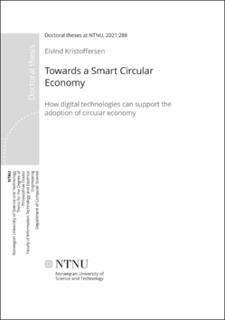| dc.contributor.advisor | Li, Jingyue | |
| dc.contributor.advisor | Mikalef, Patrick | |
| dc.contributor.advisor | Nowostawski, Mariusz | |
| dc.contributor.advisor | Blomsma, Fenna | |
| dc.contributor.advisor | Røstad, Lillian | |
| dc.contributor.author | Kristoffersen, Eivind | |
| dc.date.accessioned | 2021-09-06T07:21:45Z | |
| dc.date.available | 2021-09-06T07:21:45Z | |
| dc.date.issued | 2021 | |
| dc.identifier.isbn | 978-82-326-5669-1 | |
| dc.identifier.issn | 2703-8084 | |
| dc.identifier.uri | https://hdl.handle.net/11250/2773638 | |
| dc.description.abstract | The digital transformation holds much potential for solving some of society’s grandest and most pressing challenges, such as climate change and resource depletion. Specifically, digital technologies (DTs) represent a major opportunity to accelerate the circular economy (CE) transition. However, effectively managing this joint transformation is challenging, and firms struggle to understand how DTs support circular strategies and which business analytics (BA) resources and capabilities they should target. Addressing this gap, the thesis first establishes a reference framework for circular strategies along with a digital CE framework, enabling researchers, practitioners, and policymakers to better align their activities across boundaries in the information systems and CE fields. Next, drawing on the resource-based view and the resource orchestration view of the firm, the thesis investigates which BA resources are essential for CE and how to leverage them towards a firm-wide BA capability for CE. Finally, a conceptual model summarizes the mechanisms of how BA improves firms’ CE implementation, resource orchestration capability, and firm performance.
The thesis followed a sequential mixed methods research design, starting from an exploratory approach to uncover key concepts and their relationships, followed by a confirmatory study to examine effects. Both qualitative and quantitative cross-sectional data were sought to empirically examine the conceptual model. In total, one in-depth case study, 15 expert interviews, and a quantitative survey of 125 European firms were performed.
The resulting contributions add new knowledge to both the CE and information systems fields by detailing how DTs can increase the efficiency and enhance the effectiveness of circular strategies. First, by two reference frameworks and a process methodology providing systematic support from the strategic level of CE and digital objectives to the operational level of data science processes. Second, by a conceptual model and associated BA resources and capability of how firms manage this transition to improve their corporate reputation and environmental, financial, and competitive performance. Third, by detailing the mechanisms and effects of DTs on circular strategies and performance effects. In closing, research, practice, and policy implications are discussed, along with avenues for future research. | en_US |
| dc.language.iso | eng | en_US |
| dc.publisher | NTNU | en_US |
| dc.relation.ispartofseries | Doctoral theses at NTNU;2021:288 | |
| dc.relation.haspart | Paper 1: Blomsma, Fenna; Peroni, Marina; Kravchenko, Mariia; Pigosso, Daniela; Hildenbrand, Jutta; Kristinsdottir, Anna Rùna; Kristoffersen, Eivind; Shabazi, Sasha; Nielsen, Kjartan Due; Jönbrink, Anna-Karin; Li, Jingyue; Wiik, Carina; McAloone, Tim C. Developing a circular strategies framework for manufacturing companies to support circular economy-oriented innovation. Journal of Cleaner Production 2019 ;Volum 241. https://doi.org/10.1016/j.jclepro.2019.118271 | en_US |
| dc.relation.haspart | Paper 2: Kristoffersen, Eivind; Blomsma, Fenna; Mikalef, Patrick; Li, Jingyue. The smart circular economy: A digital-enabled circular strategies framework for manufacturing companies. Journal of Business Research 2020 https://doi.org/10.1016/j.jbusres.2020.07.044 This is an open access article under the CC BY license (http://creativecommons.org/licenses/by/4.0/). | en_US |
| dc.relation.haspart | Paper 3: Kristoffersen, Eivind; Omotola, Oluseun Aremu; Blomsma, Fenna; Mikalef, Patrick; Li, Jingyue. Exploring the Relationship Between Data Science and Circular Economy: An Enhanced CRISP-DM Process Model. Lecture Notes in Computer Science (LNCS) 2019 ;Volum 11701 LNCS. s. 177-189 https://doi.org/10.1007/978-3-030-29374-1_15 | en_US |
| dc.relation.haspart | Paper 4: Kristoffersen, Eivind; Mikalef, Patrick; Blomsma, Fenna; Li, Jingyue. Towards a business analytics capability for the circular economy. Technological Forecasting and Social Change 2021 https://doi.org/10.1016/j.techfore.2021.120957 This is an open access article under the CC BY license (CC BY 4.0) | en_US |
| dc.relation.haspart | Paper 5: Kristoffersen, Eivind; Mikalef, Patrick; Blomsma, Fenna; Li, Jingyue. The effects of business analytics capability on circular economy implementation, resource orchestration capability, and firm performance. International Journal of Production Economics 2021 ;Volum 239. s. 1-19 https://doi.org/10.1016/j.ijpe.2021.108205 This is an open access article under the CC BY license (CC BY 4.0) | en_US |
| dc.title | Towards a Smart Circular Economy: How digital technologies can support the adoption of circular economy | en_US |
| dc.type | Doctoral thesis | en_US |
